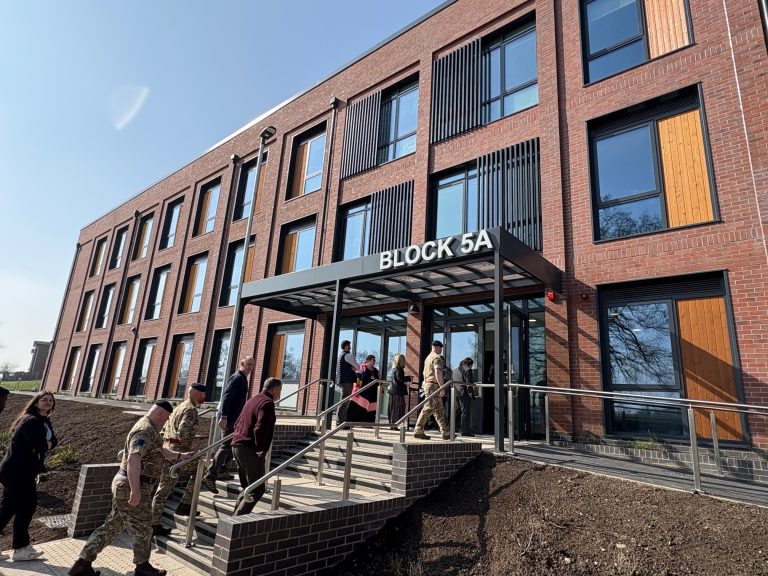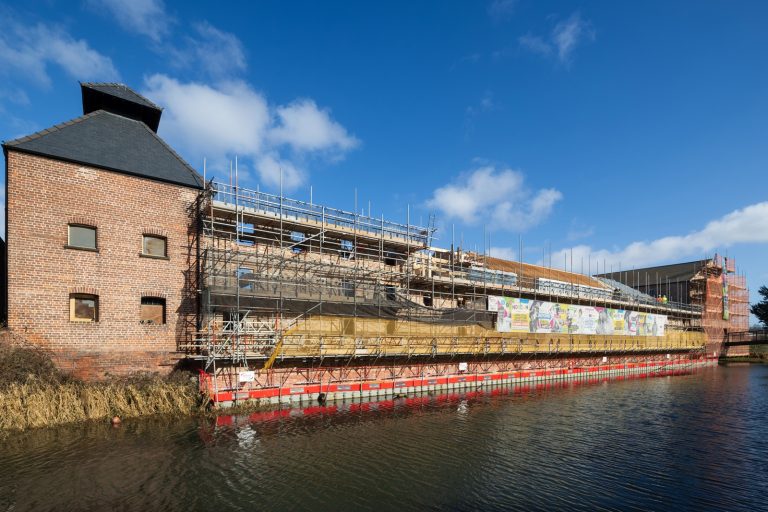Grimsby’s pioneering new Horizon Youth Zone has reached a major construction milestone, with work now complete on the roofline of the final building, which offers a first glimpse of how the development will look on the town’s skyline. Located on Garth Lane, the development is being delivered by national charity OnSide, in partnership with North East Lincolnshire Council, which is contributing to the development as part of the Greater Grimsby Town Deal, and the Department of Culture Media and Sport, through the Youth Investment Fund. The site is being transformed by Yorkshire and Lincolnshire construction firm, Hobson & Porter and is due to open this autumn. As part of the work, a series of Grade II listed 19th century maltings and grain store buildings, known as West Haven Maltings and Migar House, have been fully restored and repurposed. The middle part of the building sits at the heart of the development alongside the River Freshney and on a river wall which had to be rebuilt using a pontoon in the river to create a safe working platform. The building had fallen into a state of disrepair but it has been rebuilt, and work is now complete on its new roof structure. In addition to the refurbishment and restoration aspects of the project, the final piece of the scheme will see Hobson & Porter constructing a large outdoor multi-use games area (MUGA). Horizon Youth Zone will offer a safe and inspiring place for young people aged 8 to 19, and up to 25 for those with additional needs, to enjoy their leisure time. There will be over 20 activities taking place each evening, for just £5 annual membership and 50p per visit, including football, boxing, climbing, creative arts, music, drama and employability training. Joe Booth, Business Development Director from Hobson & Porter, said: “With construction due to complete this summer ahead of the Youth Zone opening in autumn, this part of the development and restoration of the building, which was in a poor state of disrepair, is an achievement worth marking for the whole project team. “It’s been a highly complex part of the scheme, that also required a retaining river wall to be built, but it’s the final piece of the jigsaw that now shows how Horizon Youth Zone will integrate into Grimsby’s skyline. The feedback we’ve received from the people of Grimsby has been fantastic, regardless of whether or not they’re connected to the project, because it’s given these buildings and this site a new lease of life and is going to make a huge difference to so many local young people, as well as bringing a state-of-the-art facility to the town.” Lucy Ottewell-Key, CEO of Horizon Youth Zone, said: “We’re delighted with how work is progressing and to see the completed roofline on this final building feels like a major milestone ahead of our opening later this year. “There’s a genuine buzz across North East Lincolnshire about Horizon Youth Zone and what it means for young people throughout the region, especially because so many local businesses, organisations and patrons are supporting us and making it possible, which is very exciting for everyone involved.” Horizon Youth Zone is an independent charity with a private sector led board, and once opened, it will be part of the OnSide network of 15 Youth Zones nationwide, which support over 50,000 young people annually. After completion, it’s estimated that Horizon could benefit up to 4,000 young people from North East Lincolnshire each year. Capital funders of Horizon Youth Zone comprise of Historic England, National Lottery Heritage Fund, The Architectural Heritage Fund, The Youth Investment Fund, Evergreen Life, St. James’s Place Charitable Foundation, Ørsted and Greencoats Wind UK. Horizon Youth Zone is also building a fabulous family of Founder Patrons, comprising of local organisations and philanthropists, who will support the Youth Zone during its first four years. Building, Design & Construction Magazine | The Choice of Industry Professionals














